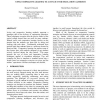Free Online Productivity Tools
i2Speak
i2Symbol
i2OCR
iTex2Img
iWeb2Print
iWeb2Shot
i2Type
iPdf2Split
iPdf2Merge
i2Bopomofo
i2Arabic
i2Style
i2Image
i2PDF
iLatex2Rtf
Sci2ools
WSC
1998
1998
Using Cooperative Learning to Activate Your Simulation Classroom
Active and cooperative learning methods represent a paradigm shift in the delivery of engineering education. These techniques recognize that the passive model of the typical college lecture does not work for many students. Instead, active and cooperative learning focuses on the premise that the students can learn best by doing and working with each other. Traditionally structured class periods imply that students listen to a professor lecture for about an hour. Cooperative learning can replace some of that lecture time with methods designed to get students actively involved during the class period. This paper presents the use of active and cooperative learning techniques applied to simulation education. Tips and examples for how to transform a standard lecture into a lecture based on cooperative exercises are given and the authors' experiences with these techniques are detailed.
Cooperative Learning | Cooperative Learning Methods | Lecture | Modeling And Simulation | WSC 1998 |
Related Content
| Added | 01 Nov 2010 |
| Updated | 01 Nov 2010 |
| Type | Conference |
| Year | 1998 |
| Where | WSC |
| Authors | Manuel D. Rossetti, Harriet Black Nembhard |
Comments (0)

